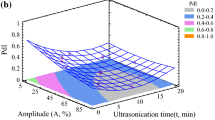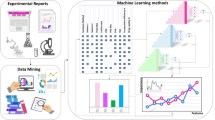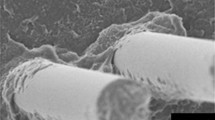Abstract
Artificial neural networks (ANNs) are a useful tool for the prediction of the particle size (PS), polydispersity index (PDI), and encapsulation efficiency (EE) of phenolic compounds (PC) in nanosystems because they consider the effects of all independent variables. This is very important for the prediction of the PS, PDI, and EE of nanosystems produced by ultrasound because the number of variables involved in the encapsulation process makes this prediction very complex. In this research work, three mathematical models for predicting the PS, PDI, and EE of PC in nanosystems produced by ultrasounds using ANN were developed. A database of scientific literature was used. These models allow the PS, PDI, and EE to be correlated mathematically with the PC mass; encapsulating copolymer concentration, ratio and mass; solvent volume; surfactant concentration; emulsion volume; and ultrasound time and power. The optimal configuration of the ANN consisted of a hidden layer with three, four, and two neurons in the hidden layer for PS, PDI, and EE, respectively. The models allowed us to predict PS, PDI, and EE for a wide range of factors. Mean square errors of 0.0538, 0.0337, and 0.0198 and correlation coefficients of 0.9139, 0.9064, and 0.8472 for PS, PDI, and EE, respectively, were obtained during training. Furthermore, mean square errors of 0.0408, 0.0224, and 0.0117 and correlation coefficients of 0.9138, 0.9115, and 0.8955 for PS, PDI, and EE, respectively, were achieved during verification.









Similar content being viewed by others
References
Abbas, S., Karangwa, E., Bashiri, M., Hayat, K., Hong, X., Sharif, H. R., & Zhang, X. M. (2015). Fabrication of polymeric nanocapsules from curcumin-loaded nanoemulsions templates by self-assembly. Ultrasound Sonochemistry, 23, 81–92.
Amani, A., York, P., Chrystyn, H., Clark, B. J., & Do, D. Q. (2008). Determination of factors controlling the particle size in nanoemulsions using Artificial Neural Networks. European Journal of Pharmaceutical Sciences, 35(1-2), 42–51.
Arunkumar, R., Prashanth, K. V. H., Manabe, Y., Hirata, T., Sugawara, T., Dharmesh, S. M., & Baskaran, V. (2015). Biodegradable poly (lactic-co-glycolic acid)-polyethylene glycol nanocapsules: an efficient carrier for improved solubility, bioavailability, and anticancer property of lutein. Journal of Pharmaceutical Sciences, 104(6), 2085–2093.
Bogue, J., Collins, O., & Troy, A. J. (2017). Chapter 2 – market analysis and concept development of functional foods. In Developing New Functional Food and Nutraceutical Products (pp. 29–45).
Coradini, K., Lima, F. O., Oliveira, C. M., Chaves, P. S., Athayde, M. L., Carvalho, L. M., & Beck, R. C. R. (2014). Co-encapsulation of resveratrol and curcumin in lipid-core nanocapsules improves their in vitro antioxidant effects. European Journal of Pharmaceutics and Biopharmaceutics, 88(1), 178–185.
Cubeddu, A., Rauh, C., & Delgado, A. (2014). Hybrid artificial neural network for prediction and control of process variables in food extrusion. Innovative Food Science & Emerging Technologies, 21, 142–150.
Elkomy, M., Elmenshawe, S., Eid, H., & Ali, A. (2017). Topical ketoprofen nanogel: artificial neural network optimization, clustered bootstrap validation, and in-vivo activity evaluation based on longitudinal dose response modeling. Drug Delivery, 7544, 1–13.
Gomes, C., Moreira, R. G., & Castell-Perez, E. (2011). Poly (DL-lactide-co-glycolide) (PLGA) nanoparticles with entrapped trans-cinnamaldehyde and eugenol for antimicrobial delivery applications. Journal of Food Science, 76(2), 16–24.
Gómez-Gómez, H., Vanz, C., Minatel, I., Luvizon, A. C., & Pereira, G. (2018). Health benefits of dietary phenolic compounds and biogenic amines. In health benefits and bioaccesibility. In J. M. Mérillon & K. Ramawat (Eds.), Bioactive Molecules in Food. Reference Series in Phytochemistry. Cham: Springer.
Hashad, R. A., Ishak, R. A. H., Fahmy, S., Mansour, S., & Geneidi, A. S. (2016). Chitosan-tripolyphosphate nanoparticles: optimization of formulation parameters for improving process yield at a novel pH using artificial neural networks. International Journal of Biological Macromolecules, 86, 50–58.
Hill, L., & Gomes, C. (2014). Characterization of temperature and pH-responsive nanoparticles for the release of antimicrobials. Materials Research Express, 1(3), 1–7.
Hill, L. E., Taylor, T. M., & Gomes, C. (2013). Antimicrobial efficacy of poly (DL-lactide-co-glycolide) (PLGA) nanoparticles with entrapped cinnamon bark extract against Listeria monocytogenes and Salmonella typhimurium. Journal of Food Science, 78(4), 626–632.
Hosseini, S., Zandi, M., Rezaei, M., & Farahmandghavi, F. (2013). Two-step method for encapsulation of oregano essential oil in chitosan nanoparticles: preparation, characterization and in-vitro release study. Carbohydrate Polymers, 95(1), 50–56.
Huang, Y., Kangas, L., & Rasco, B. (2007). Applications of artificial neural networks (ANNs) in food science. Critical reviews in food science and nutrition, 47(2), 113–126.
Jamshidi, M., Ghaedi, M., Dashtian, K., Ghaedi, A. M., Hajati, S., Goudarzi, A., & Alipanahpour, E. (2015). Highly efficient simultaneous ultrasonic assisted adsorption of brilliant green and eosin B onto ZnS nanoparticles loaded activated carbon: artificial neural network modeling and central composite design optimization. Spectrochimica Acta. Part A, Molecular and Biomolecular Spectroscopy, 153, 257–267.
Kentish, S., Wooster, T. J., Ashokkumar, M., Balachandran, S., Mawson, R., & Simons, L. (2008). The use of ultrasonics for nanoemulsion preparation. Innov. Food. Sci. Emerg. Technol., 9(2), 170–175.
Kumari, A., Yadav, S. K., Pakade, Y., Singh, B., & Yadav, S. C. (2010). Development of biodegradable nanoparticles for delivery of quercetin. Colloids and Surfaces B: Biointerfaces, 80(2), 184–192.
Lefebre, G., Riou, J., Bastiat, G., Roger, E., Frombach, K., Gimel, J. C., Saulnier, P., & Calvignac, B. (2017). Spontaneous nano-emulsification: process optimization and modelling for the prediction of the nanoemulsions size and polydispersity. International Journal of Pharmaceutics, 534(1-2), 220–228.
Li, Y., Abbaspour, M., Grootendorst, P., Rauth, A., & Wu, X. (2015). Optimization of controlled release nanoparticle formulation of verapamil hydrochloride using artificial neural networks with genetic algorithm and response surface methodology. European Journal of Pharmaceutics and Biopharmaceutics, 94(1), 170–179.
Liu, M., Yang, J., Ao, P., & Zhou, C. (2015). Preparation and characterization of chitosan hollow nanospheres for anticancer drug curcumin delivery. Materials Letters, 150, 115–117.
Mukerjee, A., & Vishwanatha, J. (2014). Formulation, characterization and evaluation of curcumin-loaded PLGA nanospheres for cancer therapy formulation. Anticancer Research, 29, 3867–3876.
Natrajan, D., Srinivasan, S., Sundar, K., & Ravindran, A. (2015). Formulation of essential oil-loaded chitosan-alginate nanocapsules. Journal of Food and Drug Analysis, 23(3), 560–568.
Neethirajan, S., & Javas, D. (2011). Nanotechnology for the food and bioprocessing industries. Food and Bioprocess Technology, 4(1), 39–47.
Ochoa-Martínez, C. I., & Ayala-Aponte, A. A. (2007). Prediction of mass transfer kinetics during osmotic dehydration of apples using neural networks. LWT - Food Science and Technology, 40(4), 638–645.
Ojha, V., Abraham, A., & Snášel, V. (2017). Metaheuristic design of feedforward neural networks: a review of two decades of research. Engineering Applications of Artificial Intelligence, 60, 97–116.
Oliveira, D., Angonese, M., Ferreira, S., & Gomes, L. (2017). Food and bioproducts processing nanoencapsulation of passion fruit by-products extracts for enhanced antimicrobial activity. Food and Bioproducts Processing, 104, 137–146.
Pereira, M., Oliveira, D., Hill, L., Carlos, R., Borges, C., Vizzotto, M., & Gomes, C. (2018). Effect of nanoencapsulation using PLGA on antioxidant and antimicrobial activities of guabiroba fruit phenolic extract. Food Chemistry, 240, 396–404.
Prakash, B., Kujur, A., Singh, P. P., Kumar, A., & Yadav, A. (2017). Plants-derived bioactive compounds as functional food ingredients and food preservative. Journal of Nutrition and Food Science, 1(1), 1–7.
Rice-Evans, C., Miller, N., & Paganga, G. (1997). Antioxidant properties of phenolic compounds. Trends in Plant Science, 2(4), 152–159.
Rigo, L., Da Silva, C., De Oliveira, S., Cabreira, T., De Bona Da Silva, C., Ferreira, J., & Beck, R. (2015). Nanoencapsulation of rice bran oil increases its protective effects against UVB radiation-induced skin injury in mice. European Journal of Pharmaceutics and Biopharmaceutics, 93, 11–17.
Shahsavari, S., Rezaie Shirmard, L., Amini, M., & Abedin Dokoosh, F. (2017). Application of artificial neural networks in the design and optimization of a nanoparticulate fingolimod delivery system based on biodegradable Poly(3-Hydroxybutyrate-Co-3-Hydroxyvalerate). Journal of Pharmaceutical Sciences, 106(1), 176–182.
Silva, H. D., Cerqueira, M. A., & Vicente, A. (2012). Nanoemulsions for food applications: development and characterization. Food and Bioprocess Technology, 5(3), 854–867.
Silva, L., Hill, L., Figueiredo, E., & Gomes, C. (2014). Delivery of phytochemicals of tropical fruit by-products using poly (DL-lactide-co-glycolide) (PLGA) nanoparticles: synthesis, characterization, and antimicrobial activity. Food Chemistry, 165, 362–370.
Singh, Y., Meher, J. G., Raval, K., Khan, F. A., Chaurasia, M., Jain, N. K., & Chourasia, M. K. (2017). Nanoemulsion: concepts, development and applications in drug delivery. Journal of Controlled Release, 252, 28–49.
Sulaiman, I. S., Basri, M., Masoumi, H. R., Ashari, S. E., Basri, H., & Ismail, M. (2017). Predicting the optimum compositions of a transdermal nanoemulsion system containing an extract of Clinacanthus nutans (L.) leaves for skin antiaging by Artificial Neural Network model. Journal of Wiley Chemometrics, 31(7), e2894.
Tao, Y., Wang, P., Wang, J., Wu, Y., Han, Y., & Zhou, J. (2017). Combining various wall materials for encapsulation of blueberry anthocyanin extracts: optimization by Artificial Neural Network and genetic algorithm and a comprehensive analysis of anthocyanin powder properties. Powder Technology, 311, 77–87.
Wang, T., Ma, X., Lei, Y., & Luo, Y. (2016). Solid lipid nanoparticles coated with cross-linked polymeric double layer for oral delivery of curcumin. Colloids and Surfaces B: Biointerfaces, 148, 1–11.
Wang, J., Liao, X., Zheng, P., Xue, S., & Peng, R. (2017). Classification of Chinese herbal medicine by laser induced breakdown spectroscopy with Principal Component Analysis and Artificial Neural Network. Analytical Letters, 51(4), 575–586.
Zhao, M., Nian, Y., Allen, P., Downey, G., Kerry, J., & ODonell, C. (2018). Performance of full cross-validation partial least squares regression models developed using raman spectral data for the prediction of bull beef sensory attributes. Data in Brief, 19, 1355–1360.
Zigoneanu, I., Astete, C., & Sabliov, C. (2008). Nanoparticles with entrapped α-tocopherol: synthesis, characterization and controlled release. Nanotechnology, 19, 1–10.
Funding
Espinosa-Sandoval, L.A. received funding from COLCIENCIAS–COLFUTURO of Colombia though the call 647 of 2014.
Author information
Authors and Affiliations
Corresponding author
Additional information
Publisher’s Note
Springer Nature remains neutral with regard to jurisdictional claims in published maps and institutional affiliations.
Rights and permissions
About this article
Cite this article
Espinosa-Sandoval, L.A., Cerqueira, M.A., Ochoa-Martínez, C.I. et al. Phenolic Compound–Loaded Nanosystems: Artificial Neural Network Modeling to Predict Particle Size, Polydispersity Index, and Encapsulation Efficiency. Food Bioprocess Technol 12, 1395–1408 (2019). https://doi.org/10.1007/s11947-019-02298-8
Received:
Accepted:
Published:
Issue Date:
DOI: https://doi.org/10.1007/s11947-019-02298-8




